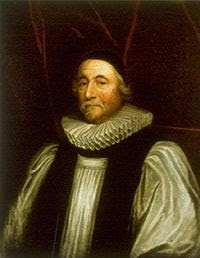If you haven't read Episode 1, hop on over and read it now. Find it here.
The idea that the world might have a beginning and an end was a new concept. It was a Jewish concept which had been co-opted by Christianity. Bishop Ussher, using all of his intellect, energy and contacts arrived at a date when the Earth was made. It was a formidable task as he had to square the genealogy of genesis with astronomy and different ways of measuring a year. Read on to find out more.

Bishop Ussher
All this frantic subdividing and classifying based on rock types and fossil assemblages allowed for a systematic assessment of the order of the ancient strata. Relatively, those early geologists knew which rocks preceded others, but no one had the faintest idea how old they were in absolute terms. Which brings us to some of the other great controversies of the geology which raged from 1650 to the middle of the 20th Century. Two thousand years ago the idea that the world might have a starting point was inconceivable.
After this, everyone was reincarnated
Most of the ancients believed that the Universe had existed forever, and that recurring cycles of creation and destruction were part of the clockwork which was so evidently displayed in the endless cycling of the heavenly bodies overhead – clear manifestations of the cyclical machinations of the Universe. The Hindus believed that the shortest cycle, the Maha Yuga, lasted 4320 000 years. A thousand Maha Yugas made up one Kalpa, and two Kalpas completed a single day in the life of Brahma. After this, everyone was reincarnated and the cycle repeated.
Known as the magnus annus – the great year
Similar ideas were manifest in ancient Greece, and Plato suggested that the length of a cycle was defined by the time it took for all the planets to return to their same relative positions in their orbits, which they had occupied at an earlier time. This time period of 36 000 years was known as the magnus annus – the great year. However just one civilisation in the ancient world ascribed to a different idea – that the heavens and the Earth had been created by God, and that there was a beginning. This Jewish notion was adopted by Christianity, and with the concept of a beginning now firmly planted in the thinking of the Christian world, it was only a matter of time before someone attempted to set a date to it.
Bishop Ussher was no fool mind you
The most influential was Bishop Ussher who set it at 6 pm on Saturday, October 22, 4004 BC. We may well pour scorn on this date but there are those who still subscribe to this improbably precise reckoning and it may still be seen in the margins of some old bibles printed around the turn of the last century. Bishop Ussher was no fool mind you. The genealogy of the book of Genesis, the biblical account of creation of the world, runs to 21 generations. Precise dates of the lengths of the lives of the various protagonists are also given, and by totting up the numbers one can arrive at a precise date of creation.

Trinity College Library
This is exactly what Ussher did. No one was more qualified than he, having learned Latin as a boy, and after joining Trinity College in Dublin in 1593, he pursued the date relentlessly, teaching himself Hebrew and Greek so as to better understand the ancient texts from which he was working. He built up Trinity College’s library into what was probably the largest collection of learned works in the world at the time – a total of 4000 volumes. He himself owned 10 000 at the end of his life. He had access to the libraries of London, Cambridge and Oxford, and rubbed shoulders with the free thinkers of the time – Frances Bacon and Ben Jonson.
Different nations had different ideas as to how long a year actually was
In 1624 at the age of 44 he was appointed Bishop of Armagh, the most senior position in the Church of Ireland. Issues of which version of the Bible to use in determining this date – for example the Greek-derived Septuagint Bible used by the Orthodox church gave dates which stretched back almost 1000 years earlier than the Hebrew-derived Bible. Adding to the difficulties was the fact that different nations had different ideas as to how long a year actually was, and different dates for the beginning of the year. In addition, astronomical records were used to help tie down dates. For example, the date of the birth of Christ was based on the following account:
“As for the other Mathias who had stirred up the sedition, Herod had him burnt alive, together with his companions. And that very night there was an eclipse of the moon.”
What qualms would he have about severing the head of a mere bishop?
The thinking was that Jesus must have been born before this date, and that the great astronomer Keppler leant his weight to this argument, opting for the date of March 14th 4 BC, which is in fact the accepted year of Jesus’ birth today. Ussher consulted far and wide, had agents in the Near East buying up ancient texts, and devoted his entire life to the quest. Secular problems also intruded into his world, including rebellion in Ireland and dodgy political connections in England which led to his arrest during the English Civil War. If Cromwell was ready to behead King Charles I, what qualms would he have about severing the head of a mere bishop?
He was a formidable scholar
Ussher managed to weather these storms to the extent that he was given a state burial by Cromwell, so esteemed was he in Irish and English society. Certainly he was a formidable scholar and made maximum use of the resources available to him, and although we can look on at his date with faint amusement, we must remember that he was a product of his age.
An institution which has provided medical care for over 300 years
The 4004 BC date may have fallen into obscurity if it hadn’t been added to the bible by a bookseller and printer, Thomas Guy. In 1675, in a simple marketing ploy to boost sales, Guy added the date into the margins of his bibles, which worked fantastically, making him a rich man. The subtle twists of fate are in fact quite breathtaking, for Thomas Guy bequeathed his fortune to Guy’s Hospital – an institution which has provided medical care for over 300 years. In 1701, the date received the official blessing of the Church of England.
Read Episode 3
A Note and an Invitation
Rock and Sky is all about physical geography, with a leaning towards geology. We bring real world examples and real world stories to assist you in your teaching. We are having fun, but it is a team effort, so please stick around, read our blog posts, leave your comments and watch us grow as we create more and more content for you.
Please share with colleagues, friends and students, and of course on Facebook, Twitter, Pinterest and LinkedIn.
Become a GeoRocker and join the Rock and Sky Facebook Group for fun and community.

